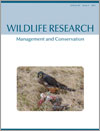Context. Changed fire regimes are an important threatening process to savanna biodiversity. Fire-sensitive vegetation such as pindan and its fauna may be particularly susceptible to fire impacts. Invasion by alien species is an additional threatening process. The toxic anuran Rhinella marina is a well publicised invader of savannas. Little is known of impacts in many habitats.
Aims. To test the hypotheses (1) that fire responses among pindan fauna are greater than general savanna responses, and (2) that cane toad-invasion impacts will be reduced relative to riparian habitats.
Methods. Reptiles, frogs, invertebrates and mammals were surveyed seven times from 2008 to 2012, four times before and three times following R. marina invasion. Time since last fire was recorded during each survey. Vegetation change was measured.
Key results. Pindan vegetation structural recovery took 4–5 years, whereas fauna recovery took only 1 year. Ground active agamids, combined Scincidae, fossorial skinks and ground-layer invertebrates responded positively to recent fire. Skinks of Ctenotus spp. declined in size after fire. Short-term fauna responses reflect rapid re-establishment of herbaceous cover. Fauna responses were detected following R. marina invasion, including increases in frogs of Uperoleia spp. and skinks of Carlia spp., and decreases in Lerista griffini and ground-layer invertebrates. Insufficient data were available to test for responses among large predators; however, >50% lower Varanus spp. trap success occurred post-invasion. No invasion response was detected among small mammals.
Conclusions. Pindan fauna fire responses were similar to those of savannas. Fauna responses to Rhinella marina invasion were relatively minor compared with those previously reported in riparian habitats and this may be related to the lower abundance of the invader here than in previous studies in riparian or more fertile habitats.
Implications. The dominant obligate seeding tree in pindan woodland, A. tumida, requires >4 years with no high-intensity fires for re-establishment of the dominant tree. Fire management should aim to minimise extensive fires to reduce impacts on fire-sensitive fauna. Persistence of large predators after cane-toad invasion suggests possible refuge value of low-productivity pindan savannas.





